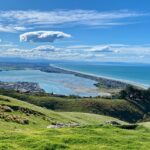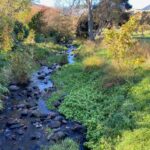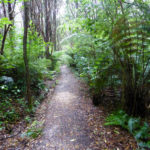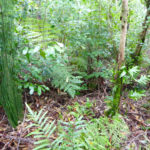Some of Christchurch’s environmental leaders gathered in August 2022 to discuss the critical issues facing our environment in preparation for local elections. Mayoral Candidate David Meates was the special guest. Stories were told of groups around Banks Peninsula and Christchurch working to regenerate the hills, valleys and streams. For example over twenty groups are working […]
Milnthorpe Park Scenic Reserve and Arboretum Golden Bay
Can introduced species play a role in restoration? Hugh Wilson of Hinewai Reserve, Banks Peninsula is a well known advocate for gorse as a nursery plant for protecting regenerating seedlings.
However, deliberately planting potentially invasive exotic species to improve soil condition and then leaving these to act as shelter is a less common approach and requires some courage.
On a recent visit to Golden Bay I stayed near the Milnthorpe Park Reserve, which is on the main route to Collingwood. At Milnthorpe, an experiment now 40 years in the making, shows this approach to be a solution.
Attempts by Land and Survey to replant the degraded coastal land in natives in 1974 failed. Later Australian species such as eucalyptus and acacia were planted with the idea of enriching the soil and providing a canopy.
This proved a successful approach – a rich humus layer and a canopy soon enabled the planting of tens of thousands of natives. The canopy also assisted the shading out of two pest weeds – gorse and Hakea.
The local community have done much of the hard work: trapping pests, planting and for the visitor making many kilometers of walking track opening the reserve up to be explored. Their work has paid off – the bush is alive with bird song.
I loved the fun routes that have been created meandering past swamps and lagoons down to the beach where you can look across sand flats to the Kahurangi National Park mountain ranges to the west and Abel Tasman National Park in the east.
If you are exploring Golden Bay and this stunning part of the top of the South Island of New Zealand do pause en route to walk in the reserve.
It is a wonderful example of the use of exotics in restoration – one that gave me pause of thought and admiration that this group took the patient and long road to success.
Visit their Website
- Swamp surrounded by both exotic and native trees
- Mixed native understory including rimu and kawakawa
- Umbrella fern covering forest floor and kanuka











Is Golden Bay well prepared for Bushfire?
NO ! We sitting on a sleeping time bomb for a Bushfire . . . Milnthorpe Forest park! Last year Milnthorpe Park was closed for visitors because of the fire risk. But the main risk is the eucalyptus tree it self, the Highway and thunderstorm with lightening . . . .
Sustainable thinking planning & working should be taking 7 generation in to there consideration before action taking place. ! ! !
According to this the Milnthorpe forest is a silent time bomb able to set the hole Kahurangi on fire and eventually destroying the local Native. 7 generation is more then 200 years. . . ! In such a long period of time it is very likely that such a fire will taking place. . . & then ??? the Eucalyptus will love the fire & will grow even stronger after each bushfire . . . the consequences . . . Eucalyptus forest taking over the hole lot. . . Native will die ! ! !
Milnthorpe is a classical example what happen if we taking the quick solution. . . 35 years a go the man wanted quick result & applause for his effort ! But his work is unfinished until the Eucalyptus trees are taken out! Please old Master let others finish your work ! you have started with good intention, so Milnthorpe Forest can be transformed in to real sustainable Native NZ subtropical wetland forest. THANKS black bear your Milnthorpe neighbor.
It’s a funny thing, but most bushfires in NZ are caused by people, not by lightning. And people will pay no attention to the species, but light anything that’s handy (accidentally or otherwise).
Milnthorpe is a lovely park and the native trees planted there are now thriving. Without the exotics, they wouldn’t be.
thanks for sharing that reminder Howard